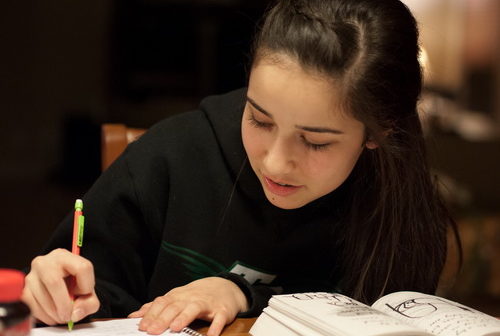Attentive kids complete their homework faster, and a well-placed and well-laid out homework station can minimize interruptions and distractions. This allows kids to power through, and gives you more family time for extracurricular activities and play. Children thrive on routine, and homework stations can help to enforce solid homework habits. With consistent use, when kids see their homework station, they automatically know how to behave. Sitting in a familiar place, surrounded by customary objects, day-in-day-out, while focused on recurring tasks creates powerful associations. Kids begin to develop a Pavlovian response to sitting at their designated workspace. A homework station can help set them up for a lifetime of good productivity habits.
Sitting Pretty
Many parents are acutely aware of the damage heavy backpacks can cause to growing spines, and most schools invest in appropriately child-sized and ergonomically designed furniture. However, when kids return home they often slouch on couches or flop on beds while studying. Time spent wriggling and writhing cuts into time spent studying! With a little forethought you can set up a dedicated area which will keep their posture protected. Use this site to calculate the ideal setup for your child’s height. (The minimum height allowance available is 5’0”, but you can scale down the seating measurements by ½” per 1” in height).
There’s no need to invest heavily in specialized furniture, but a comfortable chair is a must. Generally speaking the desk or table height is fixed, so that means the seat height must be adjustable. There are plenty of budget-priced ergonomic chairs available. Alternatively you can purchase lumbar cushions, seat boosters or even rig up firm cushions to adapt dining room chairs to the appropriate height.
On adult sized chairs, kid’s feet often swing free of the floor, but dangling legs lead to discomfort. Buy or improvise a footrest at the appropriate height.
Full Focus
Concentration is easily broken by TVs and other screens. Keep all media and gadgets away from the kids while they work. It’s a good idea to keep the entire house quiet – with no background noise from television or phone calls. Silence becomes especially important as older children approach exam time.
Some kids love to chatter and distract their siblings. You might consider physically separating them from each other. However, many parents want to supervise homework, and you don’t necessarily have to suffer the inconvenience of putting your kids in separate rooms. For many kids the pain of homework is exacerbated by isolation, so setting them up at the kitchen table to work alongside the rest of the family can really help. You can make dividing screens for each child. (See step-by-step instructions here.) These screens also minimize line-of-sight distractions. Some kids would rather watch paint dry than settle down to study, and cutting off visual stimulation can really help them focus.
Everything Is Illuminated
The homework area should be brightly lit. Task lighting is especially important, but be cautious about the positioning of desk lamps and leads. It’s easy for young kids to knock over drinks or snag on electrical cords. If you decide to use a dividing screen, (mentioned above) a spotlight clamped to the top of the screen can be a great solution. If kids are using a computer, ensure the desk lamp is angled away from the screen to prevent glare.
Stationery to Hand
Organize stationery so there are no interruptions and no time lost scavenging for paperclips. You need to keep the area clutter free as pencils and pens can turn into time wasters. This centralized revolving desk-tidy is a great way to keep everything accessible and in its proper place. Or you can buy desk organizers here.
Break It Easy
Breaks are an important part of any schedule. Planning breaks helps to keep focus unbroken. The Pomodoro Technique, (see previous article here), can be adapted for kids of any age. Let your kids know that in 25 minutes they can get a snack, pet the cat, or check on their Moshi Monsters. Keep their break-time activities within easy reach of their homework station, so when time is up you don’t need to go ferreting them out of hidey-holes around the house.
Photo courtesy of Davidjlee, Flickr.com




